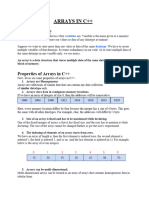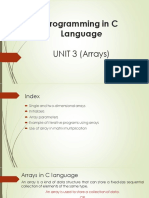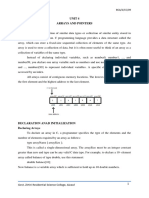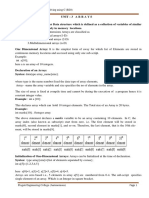PF Week 8
PF Week 8
Uploaded by
golatosami09Copyright:
Available Formats
PF Week 8
PF Week 8
Uploaded by
golatosami09Copyright
Available Formats
Share this document
Did you find this document useful?
Is this content inappropriate?
Copyright:
Available Formats
PF Week 8
PF Week 8
Uploaded by
golatosami09Copyright:
Available Formats
LECTURE NOTES / LAB HANDOUTS
PROGRAMMING FUNDAMENTALS (312-313) WEEK. 8
OBJECT: To Understand Array Fundamentals, Defining Arrays, Array Elements, Accessing Array
Elements, Initializing Arrays, Operations on Arrays Multidimensional Arrays, Two
Dimensional Array
ARRAY INTRODUCTION
An array is used to store a collection of data, but it is often more useful to think of an array as a collection of
variables of the same type. Instead of declaring individual variables, such as number0, number1, ..., and
number99, you declare one array variable such as numbers and use numbers[0], numbers[1], and ...,
numbers[99] to represent individual variables. A specific element in an array is accessed by an index. All
arrays consist of contiguous memory locations. The lowest address corresponds to the first element and the
highest address to the last element.
DECLARING ARRAYS
To declare an array in C++, the programmer specifies the type of the elements and the number of elements
required by an array as follows:
type arrayName [ arraySize ];
This is called a single-dimension array. The arraySize must be an integer constant greater than zero
and type can be any valid C++ data type. For example, to declare a 10-element array called balance of type
double, use this statement
double balance[10];
INITIALIZING ARRAYS
You can initialize C++ array elements either one by one or using a single statement as follows −
double balance[5] = {1000.0, 2.0, 3.4, 17.0, 50.0};
The number of values between braces { } can not be larger than the number of elements that we declare for
the array between square brackets [ ]. Following is an example to assign a single element of the array −
If you omit the size of the array, an array just big enough to hold the initialization is created. Therefore, if you
write
double balance[] = {1000.0, 2.0, 3.4, 17.0, 50.0};
You will create exactly the same array as you did in the previous example.
balance[4] = 50.0;
The above statement assigns element number 5th in the array a value of 50.0. Array with 4th index will be
5th, i.e., last element because all arrays have 0 as the index of their first element which is also called base
index. Following is the pictorial representation of the same array we discussed above
ACCESSING ARRAY ELEMENTS
An element is accessed by indexing the array name. This is done by placing the index of the element within
square brackets after the name of the array. For example:
double salary = balance[9];
The above statement will take 10th element from the array and assign the value to salary variable. Following
is an example, which will use all the above-mentioned three concepts viz. declaration, assignment and
accessing arrays
Course Instructor: Nazish Basir Page: 1/7
Faculty of Engineering and Technology, University of Sindh.
LECTURE NOTES / LAB HANDOUTS
PROGRAMMING FUNDAMENTALS (312-313) WEEK. 8
SOME IMPORTANT POINTS ABOUT ARRAYS
• We can access array randomly by using any index
• We can use a Loop to access all elements of an array in one by one
• Reduces code as we create many variables in one statement and use loop to access them
• Sorting and searching becomes easy as it can be accomplished by writing less line of code
• Allows a fixed number of elements to be entered which is decided at the time of declaration
PROGRAM 1: Demonstrating Simple Array.
#include<iostream>
using namespace std;
int main() {
int arr[5];
int k;
cout<<"An Integer Array..."<<endl;
cout<<"Enter 10 elements in array"<<endl;
for (k=0 ; k<5 ; k++) {
cout<<"Enter arr[" << k << "]:";
cin>>arr[k];
}
cout<<"The elements in array are:"<<endl;
for (k=0 ; k<5 ; k++)
cout<<"arr[" << k << "]: " << arr[k] << endl;
return 0;
}
Exercise 1: Write a program that takes input of 5 elements for array int a[5] and the calculate the
sum and average of the elements of array.
Course Instructor: Nazish Basir Page: 2/7
Faculty of Engineering and Technology, University of Sindh.
LECTURE NOTES / LAB HANDOUTS
PROGRAMMING FUNDAMENTALS (312-313) WEEK. 8
PROGRAM 2: Finding largest elements in an array.
#include<iostream>
using namespace std;
int main() {
int arr[10];
int loc=0, large, k;
for (k=0 ; k<10 ; k++){
cout<<"Enter element No." << k+1 << ": ";
cin>>arr[k];
}
large=arr[0];
for (k=0 ; k<10 ; k++)
if (large < arr[k]){
loc = k;
large=arr[k];
}
cout<<"The largest element is:" << arr[loc];
return 0;
}
Exercise 2: Write a program which finds the smallest element in an array
PROGRAM 3: Demonstrates array initialization and shows days from start of year to date specified
#include<iostream>
using namespace std;
int main() {
int month, day, total_days;
int days_per_month[12] = { 31, 28, 31, 30, 31, 30,
31, 31, 30, 31, 30, 31 };
cout << "\nEnter month (1 to 12): "; //get date
cin >> month;
cout << "Enter day (1 to 31): ";
cin >> day;
total_days = day; //separate days
for(int j=0; j<month-1; j++) //add days each month
total_days += days_per_month[j];
cout << "Total days from start of year is: " << total_days
<< endl;
return 0;
}
Course Instructor: Nazish Basir Page: 3/7
Faculty of Engineering and Technology, University of Sindh.
LECTURE NOTES / LAB HANDOUTS
PROGRAMMING FUNDAMENTALS (312-313) WEEK. 8
PROGRAM 4: Demonstrates different array types and their use.
#include<iostream>
#include<iomanip>
#include<conio.h>
using namespace std;
int main() {
const int size=5;
int roll_no[size];
int marks[size];
float per[size];
char grade[size];
cout<<"\nPlease enter the data for 10 students..."<<endl;
for(int i=0 ; i<size ; i++)
{
cout<<"\nPlease Enter Student No."<<i+1<<" data..."<<endl;
cout<<"Roll No.:";
cin>>roll_no[i];
cout<<"Marks out of (500):";
cin>>marks[i];
per[i] = (float)marks[i] / 500 * 100;
if(per[i]>=80) grade[i]='A';
else if(per[i]>=70 && per[i]<80) grade[i] = 'B';
else if(per[i]>=60 && per[i]<70) grade[i] = 'C';
else if(per[i]>=50 && per[i]<60) grade[i] = 'D';
else if(per[i]>=40 && per[i]<50) grade[i] = 'P';
else grade[i] = 'F';
}
cout<<"\n\nPress any key to continue....";
getch();
cout<<"\n \n \n \t \t RESULT LIST \n \n";
cout<<setw(9)<<"ROLL NO."<<setw(7)<<"MARKS"
<<setw(12)<<"PERCENTAGE"<<"\tGRADE"<<endl;
for(int i=0 ; i<size ; i++)
cout<<setw(9)<<roll_no[i]<<setw(7)<<marks[i]
<<setw(12)
<<setprecision(2) //Digit after decimal point
<<setiosflags(ios::fixed) //Do not show number in exponential form
<<setiosflags(ios::showpoint) //Alway show decimal point
<<per[i]<<"%\t"<<grade[i]<<endl;
return 0;
}
Course Instructor: Nazish Basir Page: 4/7
Faculty of Engineering and Technology, University of Sindh.
LECTURE NOTES / LAB HANDOUTS
PROGRAMMING FUNDAMENTALS (312-313) WEEK. 8
MULTI DIMENSIONAL ARRAY
C++ allows multidimensional arrays. Here is the general form of a multidimensional array declaration
type name[size1][size2]...[sizeN];
For example, the following declaration creates a three dimensional 5 . 10 . 4 integer array:
int threedim[5][10][4];
TWO-DIMENSIONAL ARRAYS
The simplest form of the multidimensional array is the two-dimensional array. A two-dimensional array is, in
essence, a list of one-dimensional arrays. To declare a two-dimensional array of size x,y, you would write
something as follows:
type arrayName [ x ][ y ];
Where type can be any valid C++ data type and arrayName will be a valid C++ identifier.
A two-dimensional array can be think as a table, which will have x number of rows and y number of columns.
A 2-dimensional array a, which contains three rows and four columns can be shown as below:
Thus, every element in array a is identified by an element name of the form a[ i ][ j ], where a is the name of
the array, and i and j are the subscripts that uniquely identify each element in a.
INITIALIZING TWO-DIMENSIONAL ARRAYS
Multidimensional arrays may be initialized by specifying bracketed values for each row. Following is an array
with 3 rows and each row have 4 columns:
int a[3][4] = {
{0, 1, 2, 3} , /* initializers for row indexed by 0 */
{4, 5, 6, 7} , /* initializers for row indexed by 1 */
{8, 9, 10, 11} /* initializers for row indexed by 2 */
};
ACCESSING TWO-DIMENSIONAL ARRAY ELEMENTS
An element in 2-dimensional array is accessed by using the subscripts, i.e., row index and column index of the
array. For example:
int val = a[2][3];
The above statement will take 4th element from the 3rd row of the array. You can verify it in the above
diagram.
Course Instructor: Nazish Basir Page: 5/7
Faculty of Engineering and Technology, University of Sindh.
LECTURE NOTES / LAB HANDOUTS
PROGRAMMING FUNDAMENTALS (312-313) WEEK. 8
PROGRAM 5: Demonstrates a double dimensional array.
#include<iostream>
using namespace std;
int main() {
int arr[5][3];
cout<<"An Integer Double Dimensional Array..."<<endl;
cout<<"Enter elements"<<endl;
for (int r=0 ; r<5 ; r++)
for (int c=0; c<3; c++) {
cout<<"Enter arr[" << r << "]["<<c<<"]:";
cin>>arr[r][c];
}
cout<<"The elements in array are:"<<endl;
for (int r=0 ; r<5 ; r++){
for (int c=0; c<3; c++)
cout<<arr[r][c]<<" ";
cout<<endl;
}
return 0;
Course Instructor: Nazish Basir Page: 6/7
Faculty of Engineering and Technology, University of Sindh.
LECTURE NOTES / LAB HANDOUTS
PROGRAMMING FUNDAMENTALS (312-313) WEEK. 8
Exercise 3: Write a program in C++ for addition of two Matrices of same size (3 x 3).
Input the element of the square matrix (3 x 3 )
Input elements in the first matrix:
[0][0] : 9
[0][1] : 8
[0][2] : 7
[1][0] : 6
[1][1] : 5
[1][2] : 4
[2][0] : 3
[2][1] : 2
[2][2] : 1
Input elements in the second matrix:
[0][0] : 1
[0][1] : 2
[0][2] : 3
[1][0] : 4
[1][1] : 5
[1][2] : 6
[2][0] : 7
[2][1] : 8
[2][2] : 9
The First matrix is :
9 8 7
6 5 4
3 2 1
The Second matrix is :
1 2 3
4 5 6
7 8 9
The Addition of two matrix is :
10 10 10
10 10 10
10 10 10
Course Instructor: Nazish Basir Page: 7/7
Faculty of Engineering and Technology, University of Sindh.
You might also like
- High Performance Techniques For Microsoft SQL ServerDocument307 pagesHigh Performance Techniques For Microsoft SQL ServerLuigui GarcíaNo ratings yet
- Cc103 Miterm Reviewer PDFDocument27 pagesCc103 Miterm Reviewer PDFRalph LawrenzeNo ratings yet
- Lab 4Document12 pagesLab 4Khawar KhalilNo ratings yet
- PF_WEEK TENDocument36 pagesPF_WEEK TENsajawalarshisohbanadnanNo ratings yet
- PL2 Lab4Document7 pagesPL2 Lab4Moeen Ul IslamNo ratings yet
- Lab Manual 04: CSC 2207 Programming Language 2 (EEE)Document7 pagesLab Manual 04: CSC 2207 Programming Language 2 (EEE)Mohammad AlamNo ratings yet
- Arrays in C++Document8 pagesArrays in C++ahmed mohamedNo ratings yet
- ArrayDocument15 pagesArrayadarsh rajNo ratings yet
- Lecture 9-C++ ArraysDocument19 pagesLecture 9-C++ ArraysorodizodanieloNo ratings yet
- 8-Lecture8 ODM103 C++ArraysDocument9 pages8-Lecture8 ODM103 C++ArraysmbogolelabenjaminNo ratings yet
- Chapter One: Fundamentals of Programming IIBHUDocument12 pagesChapter One: Fundamentals of Programming IIBHUNahum ArayaNo ratings yet
- PF Ue Lec 6Document20 pagesPF Ue Lec 6hamzaamir9733No ratings yet
- Topic 1 CSC138Document11 pagesTopic 1 CSC138Syihan ManafNo ratings yet
- C++ Chapter 5 Arrays and StringDocument15 pagesC++ Chapter 5 Arrays and StringHanan FuadNo ratings yet
- Chapter 5 C++ ArrayDocument46 pagesChapter 5 C++ ArrayGemechis GurmesaNo ratings yet
- CHAPTER 1 Aray & StringsDocument38 pagesCHAPTER 1 Aray & Stringsdillasemera2014No ratings yet
- Chapter 4 Arrays & StringsDocument36 pagesChapter 4 Arrays & Stringsmekuriameku99No ratings yet
- Properties of ArrayDocument6 pagesProperties of Arraysonali guptaNo ratings yet
- Lab 2 ArraysDocument9 pagesLab 2 ArraysZepoxNo ratings yet
- LO4_Arrays_2DDocument12 pagesLO4_Arrays_2DjaltitiNo ratings yet
- Lab # 13 Two Dimentional Arrays in C++Document4 pagesLab # 13 Two Dimentional Arrays in C++alizarizwan006No ratings yet
- Arrays (1D, 2D, 3D)Document20 pagesArrays (1D, 2D, 3D)atiq.rehman1105No ratings yet
- Chpter OneDocument28 pagesChpter OnemutgatkekdengNo ratings yet
- CP Unit Iii QBDocument11 pagesCP Unit Iii QBkanjaiNo ratings yet
- C Programming UNIT 3.2 ArraysDocument20 pagesC Programming UNIT 3.2 ArraysrishikaNo ratings yet
- Unit 4Document18 pagesUnit 4dawnglianiNo ratings yet
- Data Structure Lecture 4Document42 pagesData Structure Lecture 4eng.abdishakuur2022No ratings yet
- C ArraysDocument7 pagesC ArraysRavenTaleNo ratings yet
- Chapter 5Document48 pagesChapter 5mehari kirosNo ratings yet
- Pop Module 3 ArraysDocument31 pagesPop Module 3 Arraysdeepakdep2256No ratings yet
- PPL ESE 5,6 - QB ansDocument29 pagesPPL ESE 5,6 - QB ans1.maths.careNo ratings yet
- CHPT 3 Array CompleteDocument10 pagesCHPT 3 Array Completebhagwatgayal10No ratings yet
- arrysDocument12 pagesarrysl49397499No ratings yet
- Arrays 1Document26 pagesArrays 1suryafootball01No ratings yet
- Chapter NineDocument17 pagesChapter Ninen64157257No ratings yet
- UNIT II Arrays and StringsDocument30 pagesUNIT II Arrays and StringsSivasathiya G100% (1)
- Unit - IVDocument9 pagesUnit - IVmadhuri.suryavanshiNo ratings yet
- CL103 - Computer Programming - Lab # 03 (Arrays)Document20 pagesCL103 - Computer Programming - Lab # 03 (Arrays)Mohsan NaqiNo ratings yet
- PPSC Unit 3 Lesson NotesDocument14 pagesPPSC Unit 3 Lesson NotesHermione GrangerNo ratings yet
- Unit 4Document41 pagesUnit 4Laxman PagareNo ratings yet
- CP Unit-III - RIT CSEDocument22 pagesCP Unit-III - RIT CSEsrinivasu.pagadalaNo ratings yet
- One-Dimensional Arrays: TH THDocument6 pagesOne-Dimensional Arrays: TH THCarla SibalNo ratings yet
- c++-5Document31 pagesc++-5Solomon AsfawNo ratings yet
- Lecture 5 ArraysDocument13 pagesLecture 5 ArraysShahib SkNo ratings yet
- Data Structure and Algorithm - EditedDocument11 pagesData Structure and Algorithm - EditedRavi RaawatNo ratings yet
- ArraysDocument22 pagesArraysmayankchitra3No ratings yet
- Unit IV - ArraysDocument8 pagesUnit IV - ArraysSaravana Kumar RNo ratings yet
- Lesson Proper For Week 7: C++ ArraysDocument8 pagesLesson Proper For Week 7: C++ ArraysRalph LawrenzeNo ratings yet
- Chapter 7 Arrays: Int MarksDocument17 pagesChapter 7 Arrays: Int MarksLEOW CHIA WAYNo ratings yet
- Lesson Proper For Week 8: C++ Multidimensional ArraysDocument7 pagesLesson Proper For Week 8: C++ Multidimensional ArraysRalph LawrenzeNo ratings yet
- Data Structure 1 - Topic 3Document43 pagesData Structure 1 - Topic 3elaine grace lariosaNo ratings yet
- Arrays in C#: Size of The Array - 1Document40 pagesArrays in C#: Size of The Array - 1بلسم محمود شاكرNo ratings yet
- ICS103: Programming in C 7: Arrays: Muhamed F. MudawarDocument41 pagesICS103: Programming in C 7: Arrays: Muhamed F. Mudawardarwinvargas2011No ratings yet
- datastructureDocument69 pagesdatastructures.dhanapal13No ratings yet
- Chapter 5 Array & Strings PDFDocument13 pagesChapter 5 Array & Strings PDFRumman Haider100% (1)
- 4 ArrayDocument29 pages4 Arrayravi167784No ratings yet
- Updated C Programming Unit 3 FinalDocument27 pagesUpdated C Programming Unit 3 Finalwitob23385No ratings yet
- Arrays in C++Document8 pagesArrays in C++brittamnyaziNo ratings yet
- Array in C ProgrammingDocument10 pagesArray in C ProgrammingVSSainiNo ratings yet
- Advanced C Concepts and Programming: First EditionFrom EverandAdvanced C Concepts and Programming: First EditionRating: 3 out of 5 stars3/5 (1)
- Half-Full AdderDocument9 pagesHalf-Full Addergolatosami09No ratings yet
- K-Map Rules and ExamplesDocument16 pagesK-Map Rules and Examplesgolatosami09No ratings yet
- DS Lecture # 9 (Division Theorem)Document27 pagesDS Lecture # 9 (Division Theorem)golatosami09No ratings yet
- Week 6 T+L 8 Object-Oriented ProgrammingDocument1 pageWeek 6 T+L 8 Object-Oriented Programminggolatosami09No ratings yet
- p5510 Lec10 Efa3 Cfa SembasicsDocument8 pagesp5510 Lec10 Efa3 Cfa Sembasicsnil julfikarNo ratings yet
- Ejercicios Capitulos 1 y 2Document24 pagesEjercicios Capitulos 1 y 2Andrés CarranzaNo ratings yet
- Incorporate EstheticianDocument12 pagesIncorporate Estheticianlei veraNo ratings yet
- The Electric Field at A DistanceDocument8 pagesThe Electric Field at A DistanceprashantNo ratings yet
- HANDOUT - Rapid Control Prototyping With MATLAB PDFDocument19 pagesHANDOUT - Rapid Control Prototyping With MATLAB PDFmiaauuwwNo ratings yet
- Me6511 Dynamics LabDocument75 pagesMe6511 Dynamics LabEdwin PrabhuNo ratings yet
- Performance Task Math 8 Week 5 To 8 1Document2 pagesPerformance Task Math 8 Week 5 To 8 1Ernie Lahaylahay100% (2)
- cs2 Syllabus 2024Document9 pagescs2 Syllabus 2024nikulohaNo ratings yet
- VHDL ProjectDocument4 pagesVHDL ProjectJayp MistryNo ratings yet
- Caselets Data Interpretation Questions With Solutions: Join Us: Telegram - Me/GovtaddaDocument54 pagesCaselets Data Interpretation Questions With Solutions: Join Us: Telegram - Me/GovtaddaCHIRAG MATTANo ratings yet
- Chapter - 2-MLDocument63 pagesChapter - 2-MLnugusatola62No ratings yet
- CNS-CourseOverview-1st SessionDocument16 pagesCNS-CourseOverview-1st Sessionwaujax 1No ratings yet
- Baulkham Hills 2022 4U Trials & SolutionsDocument29 pagesBaulkham Hills 2022 4U Trials & Solutionsanew.name5245nNo ratings yet
- Promoting Language and STEAM As Human Rights in Education: Zehlia Babaci-WilhiteDocument273 pagesPromoting Language and STEAM As Human Rights in Education: Zehlia Babaci-Wilhiteel guyoNo ratings yet
- Political EconomyDocument8 pagesPolitical EconomyAjay YadavNo ratings yet
- Random VariableDocument15 pagesRandom VariableKhim Aporbo EtchonNo ratings yet
- @iitwale On Telegram: Decucted Portion Mathematics Code - 041 Class IxDocument2 pages@iitwale On Telegram: Decucted Portion Mathematics Code - 041 Class IxTECHNICAL RISHAVNo ratings yet
- Statistics For Economics Module TeachingDocument175 pagesStatistics For Economics Module Teachingsisayshimelis70No ratings yet
- Vector-Calculus Class Note Vector-Calculus Class NoteDocument47 pagesVector-Calculus Class Note Vector-Calculus Class NoteSuraj Gautam100% (1)
- Probability Concept and ApplicationDocument34 pagesProbability Concept and ApplicationLokaNo ratings yet
- DLP Circle and Its ArcDocument12 pagesDLP Circle and Its ArcMARK ANGELO ALLAUIGAN100% (1)
- 2019remaining Useful Life Prediction Based On A Double-Convolutional Neural Network ArchitectureDocument10 pages2019remaining Useful Life Prediction Based On A Double-Convolutional Neural Network Architectureravi kant sharmaNo ratings yet
- 01a IGCSE Maths 4MB1 Paper 1R - January 2020 Examination PaperDocument24 pages01a IGCSE Maths 4MB1 Paper 1R - January 2020 Examination PaperMehwish Arif67% (3)
- Lecture Planner - Maths - Lakshya JEE Fastrack 2025Document3 pagesLecture Planner - Maths - Lakshya JEE Fastrack 2025tan.sharma031No ratings yet
- Previous Year Question Paper For Class 12 Mathematics - 2008 Questions, CBSE - TopperlearningDocument5 pagesPrevious Year Question Paper For Class 12 Mathematics - 2008 Questions, CBSE - TopperlearningAsk TusharNo ratings yet
- Miamath APcal 03 Differentiation - Bk2 2Document8 pagesMiamath APcal 03 Differentiation - Bk2 2Mia S.No ratings yet
- IF3140 Query OptimizationDocument77 pagesIF3140 Query OptimizationJesica WNo ratings yet
- Foundations of Galois Theory Dover Books on Mathematics M. M. Postnikov download pdfDocument60 pagesFoundations of Galois Theory Dover Books on Mathematics M. M. Postnikov download pdfpustealzedy100% (7)
- Quadratic Equation JEE MAINDocument6 pagesQuadratic Equation JEE MAINAnshNo ratings yet





























































































